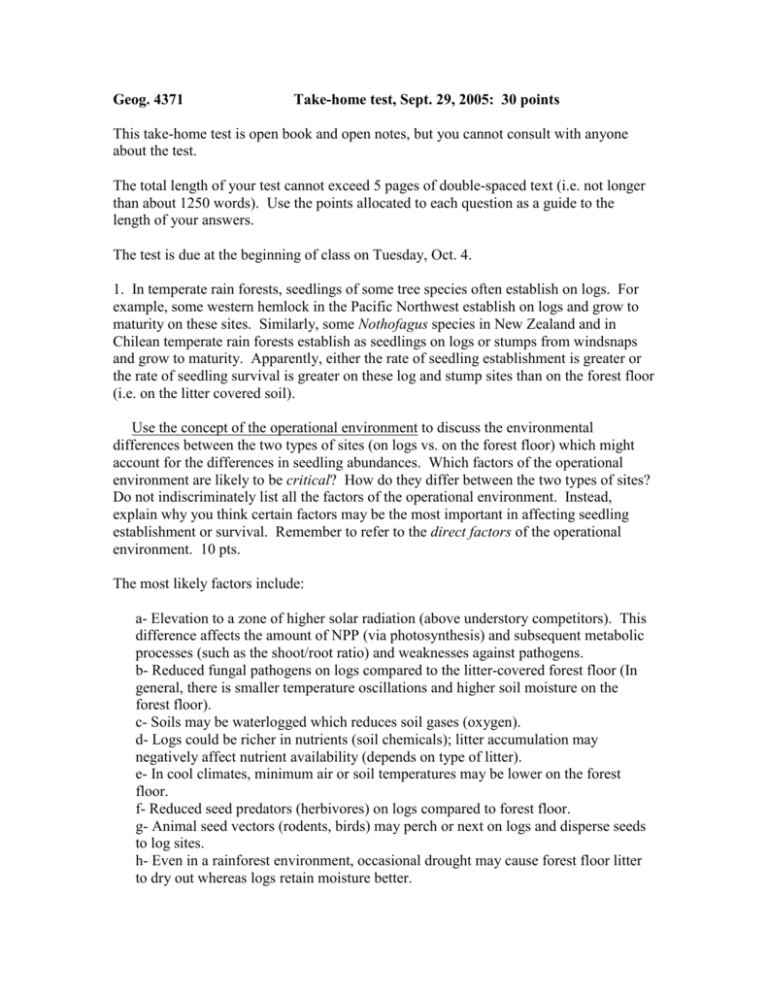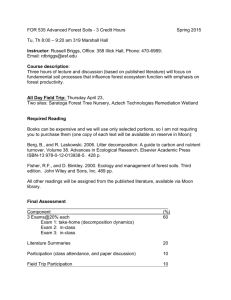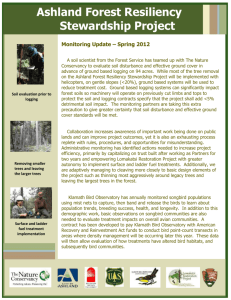Key_first_midterm
advertisement

Geog. 4371 Take-home test, Sept. 29, 2005: 30 points This take-home test is open book and open notes, but you cannot consult with anyone about the test. The total length of your test cannot exceed 5 pages of double-spaced text (i.e. not longer than about 1250 words). Use the points allocated to each question as a guide to the length of your answers. The test is due at the beginning of class on Tuesday, Oct. 4. 1. In temperate rain forests, seedlings of some tree species often establish on logs. For example, some western hemlock in the Pacific Northwest establish on logs and grow to maturity on these sites. Similarly, some Nothofagus species in New Zealand and in Chilean temperate rain forests establish as seedlings on logs or stumps from windsnaps and grow to maturity. Apparently, either the rate of seedling establishment is greater or the rate of seedling survival is greater on these log and stump sites than on the forest floor (i.e. on the litter covered soil). Use the concept of the operational environment to discuss the environmental differences between the two types of sites (on logs vs. on the forest floor) which might account for the differences in seedling abundances. Which factors of the operational environment are likely to be critical? How do they differ between the two types of sites? Do not indiscriminately list all the factors of the operational environment. Instead, explain why you think certain factors may be the most important in affecting seedling establishment or survival. Remember to refer to the direct factors of the operational environment. 10 pts. The most likely factors include: a- Elevation to a zone of higher solar radiation (above understory competitors). This difference affects the amount of NPP (via photosynthesis) and subsequent metabolic processes (such as the shoot/root ratio) and weaknesses against pathogens. b- Reduced fungal pathogens on logs compared to the litter-covered forest floor (In general, there is smaller temperature oscillations and higher soil moisture on the forest floor). c- Soils may be waterlogged which reduces soil gases (oxygen). d- Logs could be richer in nutrients (soil chemicals); litter accumulation may negatively affect nutrient availability (depends on type of litter). e- In cool climates, minimum air or soil temperatures may be lower on the forest floor. f- Reduced seed predators (herbivores) on logs compared to forest floor. g- Animal seed vectors (rodents, birds) may perch or next on logs and disperse seeds to log sites. h- Even in a rainforest environment, occasional drought may cause forest floor litter to dry out whereas logs retain moisture better. i- Thick layer of slow decaying litter on the forest floor (wet and cool = slow decay) can prevent the seedlings from rapidly developing root contact with mineral soil with adequate soil moisture and nutrients. There are other possible but less likely factors such as: i- Fewer allelochemicals (soil chemicals) on the logs than in the litter (not too likely in wet climates). j- Surface fires could kill seedlings on the forest floor (not likely in rain forests). k- Etc. 2. After logging of Douglas-fir forests in the Pacific Northwest (PNW), foresters often burn slash as a treatment to make the site more suitable for tree seedling establishment and survival. Use the concept of the operational environment to identify the changes in the environment caused by burning that are most critical to enhanced seedling establishment and survival. 5 pts. The key factors are: 1. removal of slash decreases shade, which increases solar radiation. This removal also increases the temperature oscillations (warmer during the day and cooler during the night). 2. burning of litter decreases fungal pathogens (damping off fungi). 3. removal of litter exposes bare mineral soil which usually facilitates access to soil moisture by seedlings that otherwise would have to grow longer roots to penetrate thick litter that can easily dry out. 4. burning sometimes controls weeds (competitors) in the context of the Operational Environment. 5. nutrients released by decay of ash. 6. burning can lower the risk of future low severity fires that could kill the seedlings. 3. Some ecologists try to predict future vegetation patterns of North America expected as a result of global warming associated with elevated carbon dioxide in the atmosphere based on existing relationships of plant species distributions to climate. In particular, monthly and seasonal temperature and precipitation are analyzed for the distribution of a particular plant species or community type. Then, a model of future climate is used to create a map of future vegetation patterns based on the relationships of the current vegetation to the current climate. Critically evaluate this procedure from an ecological perspective. In other words, assume that climate can be accurately predicted and just focus on the prediction of future vegetation patterns from temperature and precipitation data. 5 pts. The key factors are: a. It assumes that the species and species’ ecotypes are adapted to photoperiod (latitude controlled) of the areas of newly suitable temperature. b. It assumes that migration rate is not limiting—not all species will migrate at the same rate and therefore new associations not represented by current community c. d. e. f. types will be created. Migration rates may be intrinsically low, or existing fragmentation of natural vegetation may create dispersal barriers that cannot be overcome. It assumes soils will be suitable but in fact, soil formation is a slow process and may limit or alter the species which can establish. It ignores possibly new aspects of disturbance regime (insect outbreaks, droughts, fires, direct human action, etc.) It ignores the micro-topography that could result in different species composition. It ignores changes in the influence of chronic, long-term human action (pollution). 4. Critically evaluate the following statement: “If we know the photosynthetic light saturation curve for a tree species, we should be able to predict the success of its regeneration beneath a forest understory. “ 2 pts. No—the photosynthetic light saturation curve certainly improves our understanding regarding the potential capability of a given tree species to establish, growth and survive beneath a forest understory. As shown by the classic trench experiments other factors besides solar radiation often determine survival of tree seedlings in the understory. These factors include soil moisture and nutrients (and competition for these resources) and fungal pathogens in many or most cases. Other factors that might be important for particular species could be herbivore impacts associated with the understory environment, micro-site conditions required by certain tree species (regeneration niche). 5. What are the genetic considerations in the design of forest pest control strategies? 3 pts. There are several considerations related to the strategies. Most importantly, the strategy has to consider the rates at which the plant and pest populations reproduce. In contrast to tree species, insect pests have short generations and therefore can quickly develop genetic adaptations to chemicals or other control measures. 6. How can you predict whether wind will be a limitation on how a forest is managed? 3 pts. - If the area is known to be windy, like most rain-shadow areas at mid-latitudes (e.g. Front Range area), at the bottom of a mountain valley, at the ocean shore, or areas affected continuously by Chinook winds or rarely by very strong winds (e.g. Routt blowdown) wind will certainly have an influence on the germination, establishment, and survival of tree seedlings. Foresters will have to adapt their management strategy in order to cope with the effect of wind. -Managers should recognize the different susceptibility of different species to the effect of wind. Thus, if the management objective is to produce aspen, then wind is much less of a consideration than if the objective is to produce lodgepole. For example, in the Routt blowdown, aspen was less affected than the conifers. -Managers should also recognize the different susceptibility of different stand structures to the effect of wind (Even-aged stands are more susceptible than unevenaged stands to the effect of wind). - If foresters are managing a windy area, the shape of the clearcuts is crucial for the resulting type of airflow, which in turn will affect differently the neighboring stands. A cone-shaped opening with the narrow end toward the prevailing winds will reduce the risk of wind damage to the stands that are adjacent to the clearcuts. Clearcuts promote turbulent airflow, which enhances the rocking motion. This reduces the friction between roots and the soil, which is damaging for trees, more effectively than laminar-unidirectional wind. -In general, studying the climate and weather (wind maps) of the area planned for management may provide useful hints of the wind conditions when choosing a site. A reconnaissance in the field may give more insights about the effect of wind on the vegetation. Morphological responses are the most easiest to recognize this effect: the general physiognomy (i.e. narrow, tall trees, and limited root systems), flagging, windsnap, uprooting, wind tatter, branch breakage, leaning, dwarfing, bole shape and taper, and more swaying results in more root growth and buttresses. Additionally, tree rings may show prolonged unidirectional growth or compression wood (gymnosperms) or tension wood (angiosperms). 7. What role might fire play in maintaining the health of a forest? 2 pts. Two key factors are: a. Fire creates a range of stand ages…resulting in a more diverse landscape…with benefits to wildlife and potentially reduction in the hazard of insect outbreaks and possibly less extensive future fires…this depends on scale and severity of fire. b. Fire creates opportunities for regeneration of some species that might decline or disappear without fire. Third factor could be: c. Fire releases nutrients and accelerates biogeochemical cycling, often resulting in increased primary productivity. Or d. Fire can kill fungal pathogens and diseases that could attack trees.






